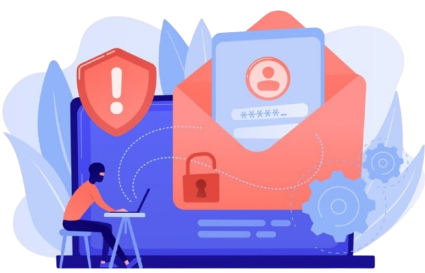- Password Managers: These tools create and securely store complex, distinct passwords for each of your accounts, ensuring that if one account is breached, the rest remain safe.
- Email Authentication Protocols: Companies can enhance their security by adopting email authentication measures such as SPF, DKIM, and DMARC, which help stop cybercriminals from impersonating your domain.
- Anti-Phishing Toolbars: Web browsers like Chrome and Firefox offer extensions that identify and block potentially harmful websites, providing warnings before you inadvertently engage with them.
Phishing Protection Guide: Secure Your
Inbox From Email Scam Attacks
Inbox From Email Scam Attacks
In the current digital landscape, our email accounts face unprecedented risks from phishing schemes. These deceitful tactics, frequently masquerading as genuine messages from reputable senders, are designed to compromise your confidential data—such as passwords, credit card details, and personal identity. It is crucial for both individuals and organizations to understand how to identify, avert, and respond to phishing attempts. This detailed guide will provide you with actionable strategies to safeguard your email and shield yourself from fraudulent communications. Visit www.duocircle.com for professional guidance and valuable insights.
What is Phishing?
Phishing is a type of cybercrime in which attackers deceive people into disclosing sensitive information by pretending to be reputable organizations through email. Such emails frequently include harmful links, attachments, or solicitations for personal data.

How to Identify a Phishing Email
Identifying phishing emails is your primary safeguard. Fraudsters employ numerous strategies to circumvent your discernment. Here are some key indicators to be aware of:
1. Suspicious Email Addresses
A phishing email could come from an address that resembles a legitimate company's domain, featuring slight variations, such as support@amaz0n.com instead of the correct support@amazon.com. It’s important to thoroughly examine the sender's email address.
2. Urgent or Threatening Language
Phishing emails frequently instill a feeling of immediacy, with messages like “Your account is at risk of suspension!” or “Immediate action required!” These strategies are designed to induce anxiety and encourage hasty decisions without careful consideration.
3. Unfamiliar Greetings or Poor Grammar
Exercise caution with emails that lack your name or contain strange wording and spelling mistakes. Genuine businesses usually uphold a professional level of communication.
4. Suspicious Links and Attachments
Avoid clicking on links or downloading files from unfamiliar sources. Before clicking, hover your mouse over the link to reveal the true URL. If it appears suspicious, it’s best to steer clear.
Best Practices for Preventing Phishing Attacks
To protect yourself from phishing attacks, it’s important to take initiative. Here are some essential strategies to implement:
1. Enable Two-Factor Authentication (2FA)
Implementing an additional security measure can safeguard your accounts in the event that your login details are exposed. Consider utilizing an authenticator application or SMS code verification for your login process.
2. Keep Your Software Updated
Make sure that your web browser, operating system, and antivirus programs are consistently updated. Regularly issued security updates fix weaknesses that could be targeted by hackers.
3. Use a Spam Filter
The majority of email services come with built-in spam filters that identify and separate potentially harmful messages. Increase the sensitivity of your filter settings to capture a greater number of possible risks.
4. Educate Yourself and Your Team
Being a member of an organization means that participating in frequent training on how to identify phishing attempts can greatly lower the risk of cyber threats. It's essential for cybersecurity awareness to be integrated into the company’s culture.
What to Do If You Fall for a Phishing Scam
Errors can occur. If you discover that you've fallen victim to a phishing email, take immediate action to minimize any potential harm.
1. Change Your Passwords Immediately
If you have submitted your login information on a fraudulent website, it’s crucial to update your passwords immediately, particularly for any accounts that share the same credentials.

2. Notify Your IT or Security Team
In the event that an attack occurs in the workplace, promptly inform your IT or security personnel. They will evaluate the situation and implement necessary measures to safeguard your network.
3. Report the Phishing Attempt
Notify your email service or the appropriate platform about the phishing email. Additionally, you may submit a report to organizations such as phishing-report@us-cert.gov.
4. Monitor Your Accounts
Monitor your banking, email, and social media accounts for any signs of suspicious behavior. If any sensitive financial details were compromised, think about setting up fraud alerts or freezing your credit.
Tools and Resources to Strengthen Your Protection
Numerous resources exist to safeguard you from phishing attacks.